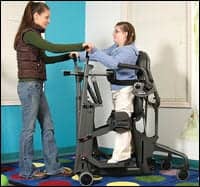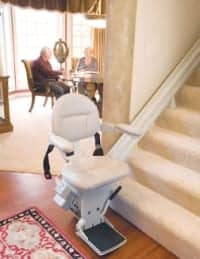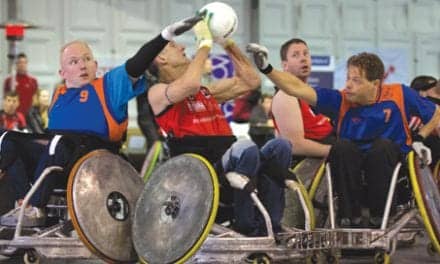 |
For children and adults who are permanently disabled, the goal to be truly included in everyday events is often met with several barriers. Not the least of these is the social stigma associated with being dependent on others for functional mobility. In the pediatric world, the introduction of the need for an assistive device can sometimes be seen as a personal defeat for the parents. Some may even view it as validation of the child being atypical.
We, as therapists, need to reframe the situation in a more positive light. With only a bit of education and product trial, parents begin to understand that assistive devices help to liberate their child, not restrict them. By supporting the child while standing or ambulating in a maximally safe environment, the device allows him or her to participate in age-appropriate activities. Obviously, every parent wants their child to be happy and integrated with their peers.
Standers are often used to assist with functional positioning in both the classroom and home environments. With the plethora of great devices on the market, the future has never looked brighter for these individuals to stand tall.
THE BENEFITS OF STANDING
The physiological benefits of a standing program and early weight-bearing have been well-described across a variety of disorders.
Standing, using knee immobilizers for additional support when necessary, can help to lengthen the muscles most at risk for contracture in the lower extremities: the rectus femoris, the hamstring group, and the gastrocnemius. These are especially prone to abnormal shortening due to the fact that they cross two joints. When we improve muscle length, we drastically change a client’s ability to maximally participate in transfers and activities of daily living, such as self-dressing. How much easier is it to get one’s pants on when the legs are straight? That level of self-empowerment goes a long way toward giving a client some control and dignity when coping with his or her disease. Ameliorating muscle balance also helps to optimize gait efficiency, improve balance reactions, and maximize joint stability.
 |
| The overall benefits of using standers are numerous. Clients can experience such improvements as reduced spasticity, improved bony modeling, and increased gastrointestinal motility. |
While there is no evidence-based research to support or deny the hypothesis, perhaps the slow, prolonged stretch may also help to lengthen the surrounding fascia. Deep fascial restrictions are often ignored during traditional range-of-motion (ROM) programs, although their negative impact is hardly denied by most practitioners. Perhaps future research will provide us with more insight in this area.
Orthopedic restrictions are not the only reason for decreased motion in many of our clients. Tonal abnormalities are often the target of many of our interventions. Studies demonstrate that you can actually decrease extensor tone in clients with spastic paraplegia using standing programs. Odeen found that you reduce extensor tone by as much as 32% when using a standing program that places a dual-joint stretch on both the hamstrings and the gastrocnemius.3 Other studies have confirmed that tonal inhibition and decreased spasms are a true result of standing programs, and that these effects last between 35 minutes4 and more than 12 hours.5
While these reductions can lead to improved patient comfort, do they allow for more active motion? Some evidence seems to suggest that they do. Odeen associated the reduction in hypertonicity with gains in both active and passive ROM, especially with regard to hip abduction. Improved abduction can help to improve a patient’s ability to step over and around obstacles, thereby increasing his or her safety in the environment.10
For children with congenital insults, working toward early motor milestones often requires the use of assistive devices. In typically developing children, full weight-bearing through the legs is typically achieved at around 9 months of age. As the plantar reflex is integrated, the child can cruise and stand with minimal assistance. In nontypical children, if very little weight-bearing is achieved by 1 year, a stander should certainly be considered to optimize hip development. Standing programs can positively influence both acetabular and femoral neck alignment.9 This may help to prevent future instability in this key area for our children.
PHYSIOLOGICAL BENEFITS
OF STANDING
- Prevention or improvement of lower-extremity contractures, which can lead to joint subluxations and/or dislocations.1,2
- Improved bony modeling.2
- Reduction of spasticity to improve functional transfers and mobility.3,4,5
- Increased gastrointestinal motility.6,7
- Reduced frequency of renal- and urinary-tract infections.8
- Improved rib-cage expansion, leading to better secretion clearance.7
- Maintenance of bone density.9
—BAF
Other benefits from standing programs can be gained in the gastrointestinal (GI), urinary, and respiratory systems.7,8
The positive psychological sequale may even outweigh the physiological benefits with regard to overall quality of life. In one study, 69% of stander users noted that it markedly improved their quality of life.11
Being in a stander often increases social interactions and decreases the stigma associated with wheelchair use. While prejudices are expected to be put aside in professional adult interactions, most children do not have that level of abstract reasoning. When they see someone sitting down all day, they instinctively sense that something is “off.” Unfortunately for the situation, children are not often overly forgiving when verbalizing their observations. While acceptance should always be taught, sometimes that acceptance is easier to break in when the child is seen to participate in more “normal” activities. Including the child in everyday games, crafts, or other activities helps him or her to maximize his or her sense of self-worth, which should always be one of the therapist’s main concerns. While playing with his or her peers at eye level can help the child’s self esteem, some studies go so far as to associate increased standing with decreased depression.12
ARE STANDERS MEANT TO REPLACE THERAPY?
Most well-rounded therapy plans for patients with special needs include standing programs. While the benefits of these programs are multidimensional, most therapists have primarily targeted the programs to achieve ROM and postural-control goals. Their adaptability in a variety of environments, and increasing ease of use, make them popular with therapists and caretakers alike.
Standers can be used in the classroom while working on math problems, in art class while painting, or when eating a snack after school. In this way, prolonged stretching is built into the day, freeing up the therapist to devote more time in direct therapy to greater functional outcomes. Standers can also be excellent methods of assisting with adherence to home programs when other routines are not working.
Beyond being an adjunct, standers can also be well-used during individual therapy. However, the therapist must always acquaint himself or herself with all of the device’s safety features and limitations before using it dynamically. In an upright position, the child and therapist can play a gentle game of toss to work on object-manipulation and midline skills. This is particularly helpful when another set of hands is not available to assist in the session. Or, when focusing on cardiorespiratory objectives, the patient can use an incentive spirometer while upright to improve rib-cage expansion.
In older children, standers can even help with positioning when working on strengthening exercises. These children can be “working out” with pulleys or bands, while feeling posturally secure. New devices also allow for lower-extremity exercise while standing. The point is that standers are excellent ways to achieve your goals during both indirect and direct therapy sessions. No longer is the client expected to just stand there and look pretty.
STANDING AND MOVING
The thing about standers is that, by nature, they sound so static. While in the past this has been true, the proliferation of mobile standers has come to offer clients more independence. With these devices, the child no longer has to worry about getting from one end of the classroom to another, nor endure the physiological and psychological trauma of another fall. Standers also have the additional benefit of allowing you to attach a tray or basket, so that the child can carry objects such as homework, crayons, or their thermos without providing large challenges to their balance.
Recent advancements have seen the rise of power standers in the industry to assist those children with endurance concerns. For children with neurodegenerative diseases, the advantage of energy conservation is immense. As many muscles of the shoulder girdle also double as accessory muscles of inspiration, having to propel a manual mobile stander may prove to be too high of a demand for the child’s short-term respiratory status. Giving the child control of moving around both indoors and outdoors while at eye level can markedly improve his or her mental health and socialization. Imagine how happy these kids can be when you see them participate in sports such as T-ball or golf. While power wheelchairs do achieve similar goals of mobilizing around an environment, they do not allow for simultaneous stretching, bone loading, GI motility, or thorax expansion.
For some individuals who are at more advanced stages of a disease, mobile standers are not always appropriate. Individuals with poor depth perception, upper-extremity coordination, severe multisystem compromise, and/or impaired safety awareness might not be ideal candidates. However, in situations in which the physician, therapist, parents, and child agree to their benefits, mobile standers appear to have a multitude of advantages.
SUPINE VERSUS PRONE
The first time many of our clients’ parents see a classic supine stander, their reactions tend to be, “Is that some kind of medieval torture device?” Of course, as therapists, visions of weight-bearing and perfect alignment are dancing through our heads. The parents simply think we are insane.
Nowadays, even the most basic of supine standers are aesthetically appeasing. Made from easily cleanable fabrics, with numerous external supports, these devices allow us to increase the degree of weight-bearing, cardiovascular demand, and visual field alignment slowly and easily. With attachable trays, more advanced children can even be working on their laptop computers while standing.
Additionally, for children with incomplete integration of their primitive reflexes, supine standers may help to elicit the tonic labyrinthine reflex to increase extensor tone and alignment. In conjunction, for a child with limited head control, supine standers are often the first place to start.
Prone standers also allow us to graduate weight-bearing while encouraging a flexor bias. They are excellent for children with more head control, although headrests can be added to some models. A typical prone stander can allow for more gastrocnemius stretching than a supine model, but positioning and tilt angle are key. They also allow for strengthening of the upper thoracic spine, scapular stabilizers, and cervical extensors via increasing the forward tilt of the device. The therapist must always balance strengthening with the potential to compromise the child’s cardiorespiratory status. We must also watch that the securing straps are not pulled so tight that we actually restrict thoracic-wall movement.
Overall, our clients are continuing to benefit from large advances in product technology. While parents and therapists alike are always attracted to the newest and greatest toys on the market, it is the professional who must always keep each client’s individual needs paramount. Just because a power stander is available doesn’t mean that it’s the right fit. However, when it makes sense, therapists should always push the envelope to raise the overall level of therapeutic interventions offered to each client. Then, at the end of the day, we can sit back and watch him or her stand tall.
Barbara Ann Fenton, MSPT, is a pediatric physical therapist at Rehab New England/Physiotherapy Associates in Warwick, RI. For more information, contact .
REFERENCES
- Stuberg WA. Considerations related to weight-bearing programs in children with developmental disabilities. Phys Ther. 1992;72:35-40.
- Mogul-Rotman B, Fisher K. Stand up and function. Rehab Management. 2002;15(6):22-23.
- Odeen I, Knutsson E. Evaluation of the effects of muscle stretch and weight load in patients with spastic paraplegia. Scand J Rehabil Med. 1981;13:117-121.
- Tremblay F, Malouin F, Richards CL, Dumas F. Effects of prolonged muscle stretch on reflex and voluntary muscle activations in children with spastic cerebral palsy. Scand J Rehabil Med. 1990;22:171-180.
- Bohannon RW. Tilt table standing for reducing spasticity after spinal cord injury. Arch Phys Med Rehabil. 1993;74:1121-1122.
- Hoenig H, Murphy T, Galbraith J, Zolkewitz M. A case study to evaluate a standing table for managing constipation. SCI Nurs. 2001;2:74-77.
- Holland T, Holland D. Taking a stand. Rehab Management. 2006;19(2): 44-49.
- Kaplan PE, Roden W, Gilbert E, Richards L, Goldschmidt JW. Reduction of hypercalciuria in tetraplegia after weight bearing and strengthening exercises. Paraplegia. 1981;19:289-293.
- Paleg G. Standing strong. Advance for Physical Therapists and PT Assistants. 2005;16:39.
- Odeen I. Reduction of muscular hypertonus by long-term muscle stretch. Scand J Rehabil Med. 1981;13(2-3):93-99.
- Karr W. Standing improves health. Home Health Care Dealer/Provider. 2000;12(2):36.
- Chin M. Alternative positioning can help improve a child’s function at home and school. TeamRehab Report. May 1994:18-20.





